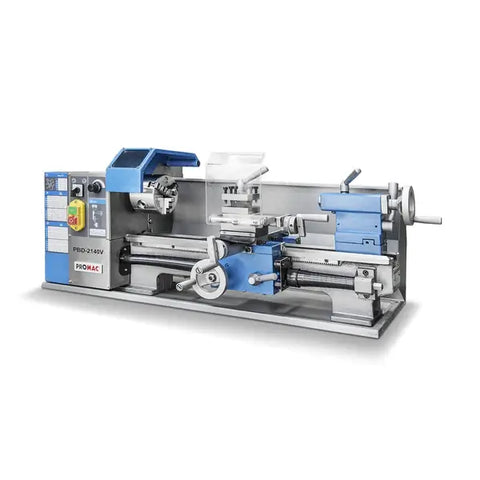
Eco-Friendly Machining: Are Lathes Sustainable?
Welcome to our exploration of eco-friendly machining, where we focus on the sustainability of lathes. In the world of woodworking, it's essential to consider sustainable practices and designs to minimize our impact on the environment. So, let's delve into the eco-friendly lathe designs and sustainable woodworking practices that can help us achieve a greener future.

Key Takeaways:
- Lathes can be sustainable if we adopt eco-friendly designs and practices.
- Woodturning can contribute to a more sustainable future by reducing its carbon footprint.
- Sustainable forestry is crucial for responsible lathe production.
- Techniques such as waste reduction and energy efficiency can make woodturning more sustainable.
- Responsible woodturning practices are essential for preserving our environment.
Sustainable Woodworking Practices
When it comes to woodturning, implementing sustainable practices is crucial for promoting environmentally friendly woodturning. In this section, we will explore different sustainable woodworking practices that can be adopted to reduce the carbon footprint of this craft.
Green Lathe Technology
One of the key aspects of sustainable woodturning is embracing green lathe technology. This refers to the use of eco-friendly and energy-efficient lathe designs that minimize resource consumption and waste. By incorporating features such as efficient motor systems, LED lighting, and automatic shutoff mechanisms, green lathes reduce energy consumption and contribute to a greener woodturning process.
Sustainable Forestry for Lathe Production
An essential element of environmentally friendly woodturning is the responsible sourcing of wood. To ensure sustainable lathe production, it is crucial to obtain wood from sustainably managed forests. Sustainable forestry practices prioritize the long-term health of forests by considering factors such as reforestation, biodiversity conservation, and responsible harvesting. By supporting sustainable forestry, woodturners can contribute to the preservation of our natural resources and mitigate the environmental impact of their craft.
| Benefits of Sustainable Woodturning Practices: |
|---|
| 1. Reduces the carbon footprint associated with lathe production. |
| 2. Conserves natural resources by sourcing wood from sustainable forestry. |
| 3. Promotes energy efficiency through the adoption of green lathe technology. |
| 4. Supports the long-term health and biodiversity of forests. |
| 5. Contributes to a more sustainable future for the woodworking industry. |
By implementing these sustainable woodworking practices, woodturners can play a vital role in creating a more environmentally friendly and responsible woodturning industry. Through the use of green lathe technology and the thoughtful sourcing of wood from sustainable forestry, we can ensure the preservation of our natural resources and contribute to a greener future.

Sustainable Woodturning Techniques
Woodturning is an art that has been practiced for centuries, but it's essential to ensure that this craft is carried out in a sustainable manner. By adopting specific woodturning techniques, we can significantly reduce the carbon footprint associated with this process and contribute to a more sustainable future for the woodworking industry.
Here are some sustainable woodturning techniques that can help minimize the environmental impact:
1. Mindful Material Selection
Choosing the right wood for your turning projects is crucial. Opt for locally sourced and sustainably harvested wood from reputable suppliers. This helps to support responsible forestry practices and reduce the transportation emissions associated with long-distance shipping.
2. Waste Reduction and Recycling
Reduce waste by planning your projects carefully to maximize material utilization. Utilize the full potential of each piece of wood to minimize off-cut waste. Additionally, consider recycling wood shavings and sawdust for other uses, such as mulching or composting.
3. Energy-efficient equipment
Invest in energy-efficient lathes and woodturning tools. Look for equipment with energy-saving features, such as variable-speed motors and automatic shut-off functions. These environmentally friendly designs can help minimize energy consumption during the woodturning process.
4. Minimalistic Design Approach
Adopt a minimalistic design approach, focusing on simplicity and functionality. By designing pieces that require fewer materials and have efficient shapes, we can reduce waste and promote sustainable consumption.
5. Eco-friendly Finishing Techniques
Choose eco-friendly finishes that are low in VOCs (volatile organic compounds) to minimize harm to the environment. Water-based finishes and natural oils are excellent alternatives to traditional solvent-based finishes.
6. Sharing Knowledge and Collaboration
Collaborate with other woodturners and share sustainable woodturning techniques. By exchanging ideas and knowledge, we can collectively advance sustainable practices within the woodworking community.
By incorporating these sustainable woodturning techniques into our craft, we can minimize our carbon footprint and contribute to a more sustainable future. Let's embrace eco-friendly practices in woodturning and ensure the preservation of our environment for generations to come.
| Technique | Benefits |
|---|---|
| Mindful Material Selection | - Supports responsible forestry practices - Reduces transportation emissions |
| Waste Reduction and Recycling | - Minimizes off-cut waste - Repurposes wood shavings and sawdust |
| Energy-efficient equipment | - Minimizes energy consumption - Reduces environmental impact |
| Minimalistic Design Approach | - Reduces material usage - Promotes sustainable consumption |
| Eco-friendly Finishing Techniques | - Lowers VOC emissions - Limits environmental damage |
| Sharing Knowledge and Collaboration | - Advances sustainable practices - Fosters community engagement |

Conclusion
In conclusion, the sustainability of lathes in modern woodworking practices is a topic of great importance. Through our exploration of eco-friendly machining, sustainable woodworking practices, and techniques, it is evident that lathes have the potential to align with sustainable principles and contribute to a greener future.
The use of environmentally friendly woodturning practices, such as implementing green lathe technology and sourcing wood from sustainable forestry, can significantly reduce the carbon footprint associated with lathe production. These practices not only benefit the environment but also promote responsible woodturning practices that prioritize the preservation of our natural resources.
By adopting sustainable woodturning techniques that aim to reduce the carbon footprint, woodturners can play a vital role in creating a more sustainable woodturning industry. From utilizing energy-efficient machinery to minimizing waste and recycling materials, every effort towards sustainability counts.
In conclusion, the question "Are lathes sustainable?" can be answered affirmatively. With the implementation of sustainable woodworking practices, eco-friendly lathe designs, and responsible woodturning techniques, lathes can indeed be a part of a sustainable future for the woodworking industry.

